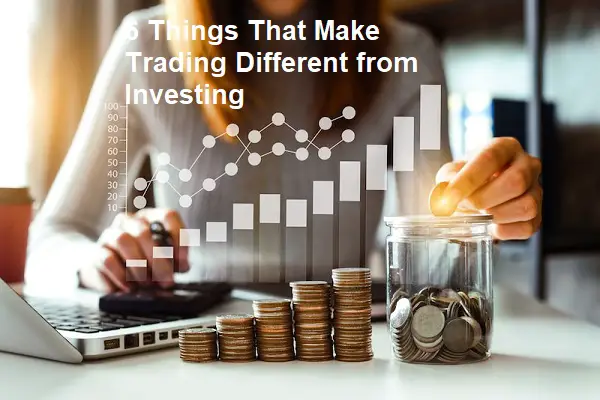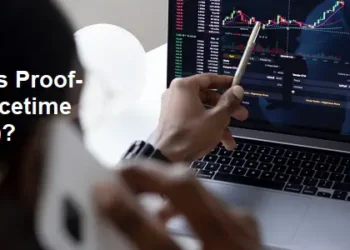If you see advertisements for forex brokers, whether it’s on YouTube or other social media platforms, they often claim that forex is an investment. And it’s as if the service they offer us is an investment service. Even though there is a clear boundary between trading and investment, even though the transaction mechanism is the same.
This misunderstanding is basically quite dangerous if no one straightens it out. In fact there were many people who were interested in registering for binary options some time ago because the platform offered “investments”, even though it was not a platform for investments. As a result, many people suffer losses and no one is held accountable.
So, in this article, let’s discuss what trading and investing are and the differences between the two.
Definition of Trading and Investment
Trading in Indonesian is defined as trading. That is, the activity of buying and selling goods to make a profit. Trading in the financial market is synonymous with the forex market, but basically trading activities can be carried out in almost all financial market instruments, such as stocks, crypto, bonds, derivative instruments and so on.
Trading is specifically done by taking advantage of price movements in the short term. Even swing traders who are long term traders are still basically in the short time category. Compared to investments made in years or decades.
Investment itself is understood as the activity of buying an asset with good prospects in the future. A good prospect means that the asset may grow many times its current price. Thus providing a big advantage for investors who buy it.
Basically the goal of investing is the same as the purpose of trading, which is to make a profit. However, the priority of investment activities is not only the benefits, but also the risks given to investors. For this reason, in some circumstances, investors do not invest for the sake of significant profits, but rather for the security of their assets.
For example, when economic conditions are unstable for one reason or another, investors usually flock to shift their portfolios to safe haven assets, such as gold, government bonds, and others.
The difference between Trading and Investing
When we read the definitions of trading and investing, maybe we will be confused, what is the difference between trading and investing? Because both of them are buying and selling assets. And in general both of these activities are carried out for profit. So, what’s the difference?
There are at least 6 things that we can use to differentiate between trading and investing.
1. Holding period
The holding period or the time to hold assets is the duration investors or traders own these assets (before selling them).
Traders have a short holding period between a few hours to a maximum of maybe a year and even then it’s very rare.
Meanwhile, investors have a relatively longer holding period than traders. Generally from one year to even tens of years. Although recently there have been several investment products that offer short-term investments, ranging from 30 days to 12 months.
2. Asset Risk
Assets have various types of risk. There are low risk, medium and high.
Trading tends to be carried out on high-risk assets. Usually because market volatility is somewhat higher than other financial markets, short-term price movements can provide quite a profit. Examples include the stock market, forex market and cryptocurrencies.
Meanwhile, investments are made in assets with a relatively low risk. Some investment products are also categorized as risky assets. But compared to trading risk, investment risk is much lower.
For example, in stock trading and stock investment, there is a significant difference in risk. Stock traders usually look for stocks that have a wide range of price movements. And generally these stocks have a market capitalization that tends to be low, compared to other types of stocks. Therefore the range of price movements is wider because the volatility is quite high.
Meanwhile, stock investments are made in stocks that have high liquidity, are widely traded, have good fundamentals, good company management and other factors that indicate that these stocks are low risk. Examples include blue chip stocks, stocks with high liquidity, large market capitalization and excellent financial condition.
3. Method
The method is the method used for trading and investing. There are many types of trading methods that are actually adopted from investment methods. Although in the end nothing is profitable.
Trading methods generally use technical analysis methods, namely analysis methods using historical price movements or patterns of price movements in the past. Examples include candlestick patterns, chart patterns, Elliot waves, harmonic patterns and so on.
Meanwhile, investments in general use fundamental analysis methods, namely analytical methods using fundamental data that affect asset movements. For example, for the stock market, investors use certain ratios calculated from data obtained in the financial reports provided by the company.
4. Capital and risk management
Due to the difference in the level of risk between trading and investing, the way to manage capital and risk between the two is also different.
Capital and risk management in trading is usually done by determining the risk per transaction based on the percentage of the capital used. Generally, traders use a risk of 1% to 5% in each transaction to avoid losses beyond the tolerance limit that can be handled by the trader’s own mentality.
While in investment, the risk limit is not determined based on a percentage of capital, but uses the maximum drawdown concept, namely the maximum decrease in assets that can be tolerated by investors. For example, the stock market is in a bullish trend and investors happen to buy these assets just before the market moves down, so the investor’s position is at the end of a bullish trend. In this situation the investor can cut loss, when the loss reaches a certain percentage of the capital, for example 25% of the capital or even 50% of the capital.
On the other hand, investors can also apply the investment diversification method, namely allocating investment capital to several different assets. So that an investment portfolio does not only contain one asset, but several assets with different types and levels of risk. The goal is to avoid losses when certain investments are experiencing a bearish trend or even crash.
5. Type of transaction
In some financial markets, for example the forex market, transactions are not only in the form of buying transactions, but can also make selling transactions and can still generate profits. But not all financial markets are like that, most selling transactions are only made when you want to take profit or take profit.
In trading, traders can generally carry out two types of buy and sell transactions to make a profit. Even if it’s in the stock market which normally only provides one-way transactions. Sell transactions or what is usually called short selling can also be done on the stock market using a margin trading mechanism. However, the impact is considered negative for the stock market, as it could exacerbate the ongoing bearish trend and could even cause a crash.
Whereas in investment, sell or short selling transactions are only carried out when investors want to cut losses or take profits. In addition, short selling using margin trading is basically not suitable for long-term transactions because it is risky. Therefore, in stock investment and even other investments there is no short selling facility.
6. Purpose
The purpose of trading and investing is indeed the same to make a profit. However, there is a difference between the goals of traders and investors.
Trading is identified as a business, for that trading can be used as a profession where traders make a living from this activity. That is why there is the term trading for living, which is when traders become a profession and the main source of income.
Meanwhile, investment is identified as an activity of managing money and not as a profession that is a source of income. Investment is generally a side activity outside of the main job. Even though there are some people whose activities are only investing, for example Lo Kheng Hong, but because he is a big investor where the proportion of ownership in a company’s shares does not include 1% or 2%, but dozens to tens of percent so that the investment profits can cover living expenses.









